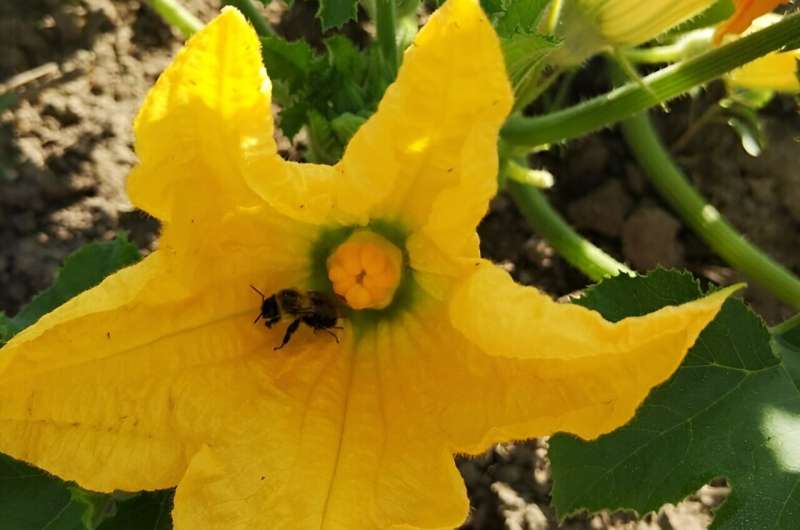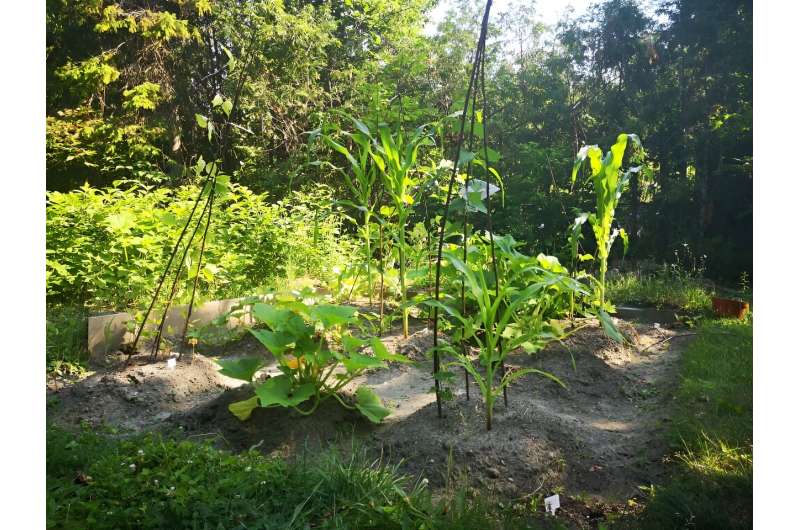This article has been reviewed according to Science X's editorial process and policies. Editors have highlighted the following attributes while ensuring the content's credibility:
fact-checked
peer-reviewed publication
trusted source
proofread
Three sisters garden study finds balanced pollinator-plant network faces an uncertain future

The loss of even one wild bee species can disrupt the reproductive success of certain plants resulting in fewer vegetables, fruits and flowers, say York University researchers who studied how pollinators and plants rely on each other, specifically in Indigenous gardens in the Great Lakes Region.
Pollination deficits can threaten global food security. A decline in the bounty of plants can in turn lead to fewer resources for pollinators and put their survival at increased danger. Researchers at York University delved into its significance using a three sisters garden, along with additional culturally significant plants to see what was abuzz.
"This delicately balanced pollinator-plant network is at risk of future human-caused collapse, but it has not been well studied and there has been little understanding of how this co-reliance works and the threats against it," says York University Ph.D. Candidate Shelby Gibson of the Faculty of Science in the lab of co-author York University Associate Professor Sheila Colla of the Faculty of Environmental and Urban Change (EUC).
Additional co-authors include Thomas Onuferko, a York Ph.D. Faculty of Science graduate now of the Canadian Museum of Nature, and Associate Professor Lisa Myers of EUC.
The three sisters garden uses an ancestral Indigenous growing method, a form of intercropping that involves the growth of multiple crops simultaneously, including culturally important medicinal plants.
However, land use changes, the use of pesticides and other agricultural practices, the invasion of non-native species and climate change are increasingly impacting how pollinators and plants match up.
The study, "Determining the plant-pollinator network in a culturally significant food and medicine garden in the Great Lakes region," published May 22 in the journal PeerJ, looked at how the pollinator community visiting the garden differed from the surrounding wild pollinator community.

"Knowing what is involved with these pollinator-plant networks can help us minimize future disruptions that could result in the loss of both plants and wild bee species," says Colla. "It can also provide us with baseline information about the role of wild bees and the stability of the network to weather environmental change."
The three sisters garden has corn, common bean and squash, which rely on insect pollination. For squash, the pollination window is short—their flowers open at dawn and close by noon—and it is historically pollinated by the hoary squash bee.
Overall, some 37 species, or 59%, of the about 63 bee species thought to occur in the wider community were identified in the garden. Bumblebees were the most frequent genus with the most frequent species being the common eastern bumble bee. Equally as common as the common eastern bumble bee, was the hoary squash bee. These bees interacted mostly with Patty Pan squash.
The hoary squash bee is recognized as a key species for the three sisters garden and an important pollinator to protect. They have specialized hairs for collecting squash pollen and are extremely active during the squash pollination window.
Although the range of the hoary squash bee has grown, it doesn't typically include wild squash and its range has been impacted by continued agricultural expansion. In their absence, honey bees and bumble bees are known to be able to pollinate squash, but it is the aptly named hoary squash bee that has co-evolved with the plant.
Recommendations for management of the hoary squash bee within the agroecosystem are to minimize pesticide exposure, provide nesting sites (they are ground nesters), maintain field proximity, monitor populations, parasites, and pathogens, and limit deep tillage of the earth. Many of the things already in practice at the three sister garden.
The researchers say further research is necessary to ascertain how to manage ongoing threats to the common eastern bumble bee and the hoary squash bee, both important pollinators in the three sisters garden system, but also the overall critical role of wild pollinators for culturally significant plants. This could include the role of policies and programs that support and promote conservation and pollinator-plant diversity.
More information: Shelby D. Gibson et al, Determining the plant-pollinator network in a culturally significant food and medicine garden in the Great Lakes region, PeerJ (2024). DOI: 10.7717/peerj.17401
Journal information: PeerJ
Provided by York University




















